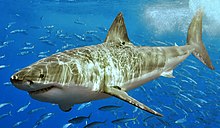Study indicates as great white shark disappears, living fossil moves in
Saturday, February 16, 2019
On Wednesday, scientists from the University of Miami and Apex Shark Expeditions published a study in Scientific Reports, an on-line journal, documenting the disappearance of the great white shark (Carcharodon carcharias) from a specific area off the coast of South Africa. The study found that when the whites disappeared, a Jurassic-era predator called the sevengill shark (Notorhynchus cepedianus) moved in.
The study was a collaborative project between Neil Hammerschlag of the Rosenstiel School of Marine and Atmospheric Science at the University of Miami and Chris Fallows of Apex Shark Expeditions, a company that conducts cage diving and shark viewing trips.

Image: Pterantula.
The study covered more than 8000 hours of shark observations in South Africa's False Bay spread out over the past 18 years. The great white shark population remained relatively stable until 2015, at which point their numbers went into sharp decline, sometimes reaching zero during 2017–2018. At those times, another predator, the sevengill shark, previously unknown in the study area, began to appear. The sevengill is sometimes called a living fossil because it closely resembles similar sharks from prehistoric times.
Fallows remarked, "In 18+ years of working at Seal Island, we had never seen sevengill sharks in our surveys[...] Following the disappearance of white sharks in 2017, sevengill began to show up for the first time and have been increasing in number ever since."
The study itself outlined the tight correlation between the absence of white sharks and the presence of sevengills: "[S]evengill sharks [...] were only detected during the prolonged periods of complete white shark absence, disappearing from our surveys during the intermittent short periods when white sharks temporarily returned to Seal Island, albeit in very low numbers, only to reappear when the white sharks were again absent from surveys[.]"

Image: Robert Pittman, NOAA.
The sevengill shark usually lives in areas where the sea floor is thick with kelp, as opposed to the relatively clear-bottomed study area. The sevengill and great white are both ordinarily apex predators and seek some of the same food, such as cape fur seals, but great whites can also prey directly on sevengills. The great white shark and orca are the only species known to eat adult sevengills. The sevengill has seven gills, whereas most species of shark have only five gills on each side of their bodies.

Image: derekkeats.
The scientists behind the present study only noted various hypotheses about the cause of the disappearance of great white sharks from this area, though Dr. Alison Kock of the University of Cape Town has reported a correlation with the entry of orcas into False Bay, possibly because human activity has rendered prey hard to find elsewhere. These orcas, she suggested, specialize in hunting sharks.
The researchers noted the sevengill sharks might not have the same effect on the ecosystems involved as the great whites have had, citing the ecological disruption apparently caused off Alaska when a change in orca behavior had a knock-on effect, disrupting sea otters' predation of sea urchins, whose population then exploded, plowing through the area's kelp forests.
Sources
- "South Africa wants its great white sharks back: Cape Town waters invaded by sevengills" — NZ Herald, February 14, 2019
- "New study finds ecosystem changes following loss of great white sharks" — University of Miami, February 13, 2019
- Neil Hammerschlag, Lacey Williams, Monique Fallows, and Chris Fallows. "Disappearance of white sharks leads to the novel emergence of an allopatric apex predator, the sevengill shark" — Scientific Reports, February 13, 2019
- Jay Caboz. "'New' killer whales have moved to South Africa - and are feasting on local great white sharks" — Business Insider South Africa, February 5, 2019
- "Apex Shark Expeditions" — Apexpredators.com, January 25, 2019 (date last updated)
- J.A. Estes, M.T. Tinker, T.M. Williams, D.F. Doak. "Killer Whale Predation on Sea Otters Linking Oceanic and Nearshore Ecosystems (Abstract)" — Science (journal), October 16, 1998
